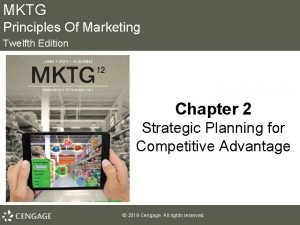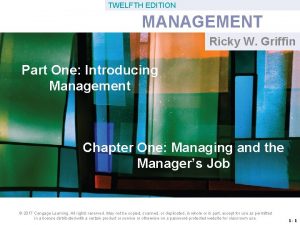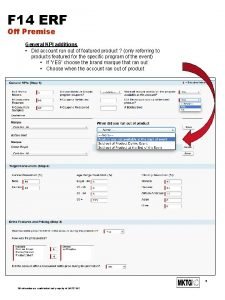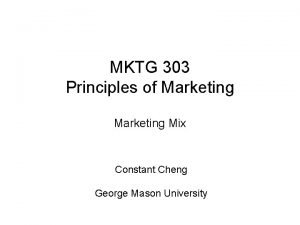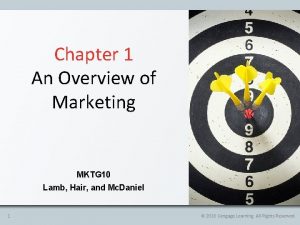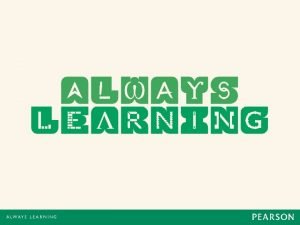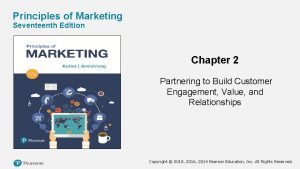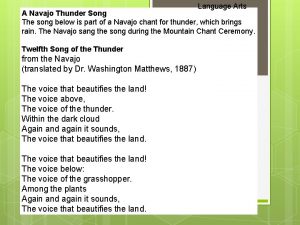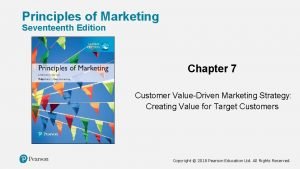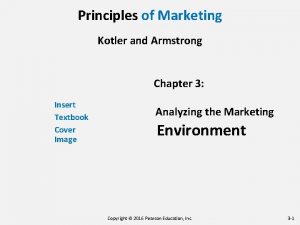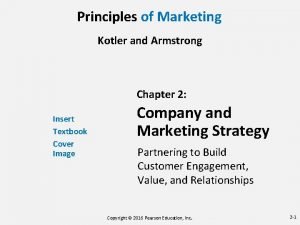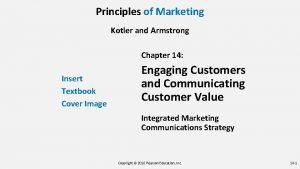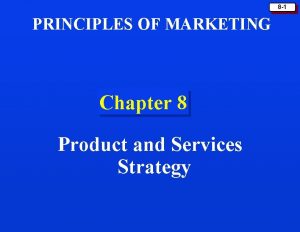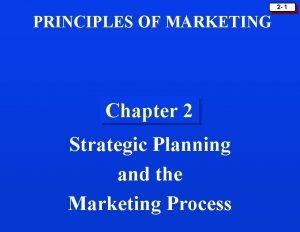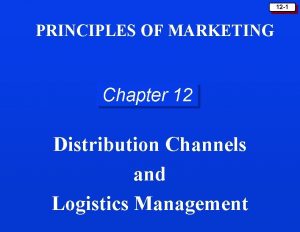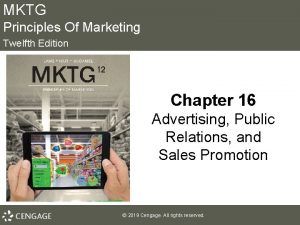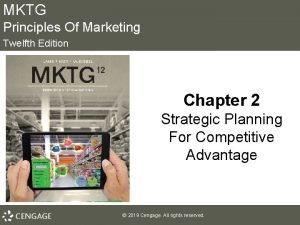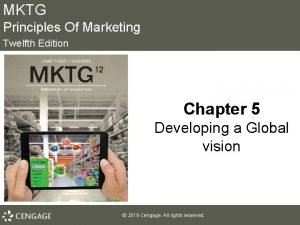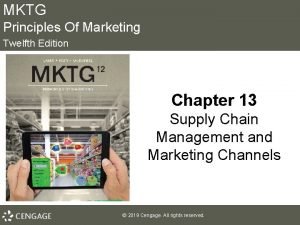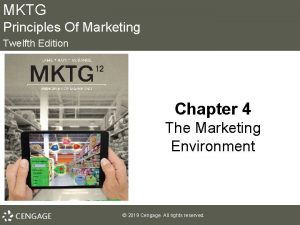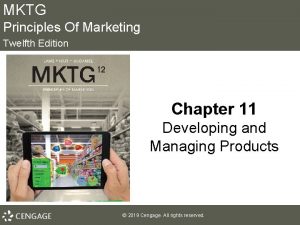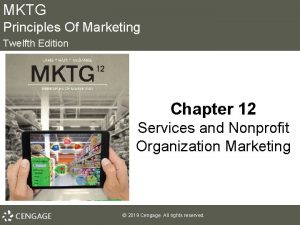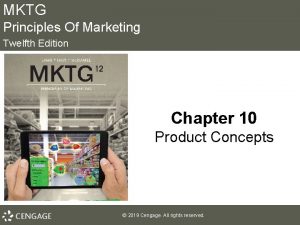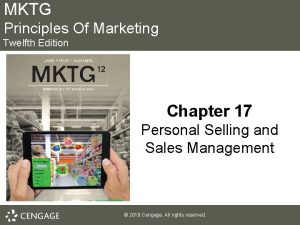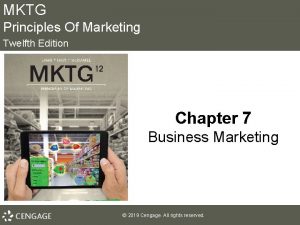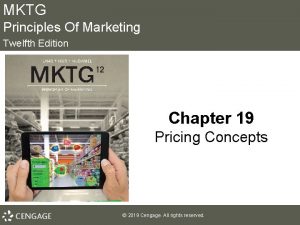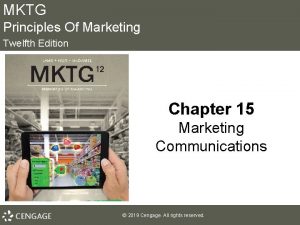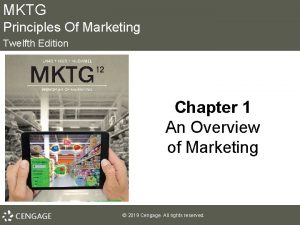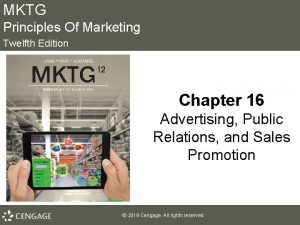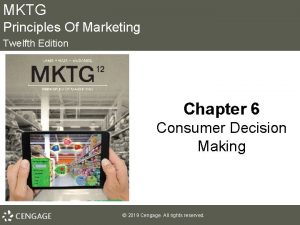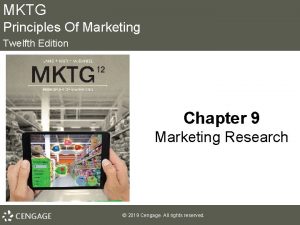MKTG Principles Of Marketing Twelfth Edition Chapter 14







































- Slides: 39

MKTG Principles Of Marketing Twelfth Edition Chapter 14 Retailing © 2019 Cengage. All rights reserved.

Learning Outcomes (slide 1 of 2) 14 -1 Explain the importance of the retailer within the channel and the U. S. economy 14 -2 List and understand the different types of retailers 14 -3 Explain why nonstore retailing is on the rise, and list the advantages of its different forms 14 -4 Discuss the different retail operations models, and understand why they vary in strategy and format © 2019 Cengage. All rights reserved.

Learning Outcomes (2 of 2) 14 -5 Explain how retail marketing strategies are developed and executed 14 -6 Discuss how services retailing differs from goods retailing 14 -7 Understand how retailers address product/service failures, and discuss the opportunities that service failures provide 14 -8 Summarize current trends related to customer data, analytics, and technology © 2019 Cengage. All rights reserved.

The Importance of Retailing • • • Retailing: all activities directly related to the sale of goods and services to the ultimate consumer for personal, nonbusiness use Retailer: a channel intermediary that sells mainly to consumers Retail industry in the United States – Comprises mostly small businesses – Dominated by a small number of large companies – Approximately 66 percent of U. S. GDP comes from retail activity © 2019 Cengage. All rights reserved.

Types of Retailers and Retail Operations • Retail establishments can be classified based on: − − Type of ownership Level of service Product assortment Price © 2019 Cengage. All rights reserved.

Ownership Arrangement • • • Independent retailer: a retailer owned by a single person or partnership and not operated as part of a larger retail institution Chain store: a store that is part of a group of the same stores owned and operated by a single organization Franchise: a relationship in which business rights to operate and sell a product are granted by the franchisor to the franchisee – Franchisor: The originator of a trade name, product, methods of operation, and the like that grants operating rights to another party to sell its product – Franchisee: an individual or business that is granted the right to sell another party’s product © 2019 Cengage. All rights reserved.

Level of Service • Level of service – Ranges from full-service to self-service – Provides alterations, credit, delivery, consulting, liberal return policies, lay-away, gift-wrapping, and personal shopping © 2019 Cengage. All rights reserved.

Product Assortment • Product assortment is based on the width and depth of product lines – Width is the assortment of products offered – Depth is the number of different brands offered within each assortment © 2019 Cengage. All rights reserved.

Price • Gross margin: the amount of money the retailer makes as a percentage of sales after the cost of goods sold is subtracted – Prices in any store format might not vary just from day to day, but minute to minute – The rise of mobile devices has added a new layer of complexity to pricing decisions © 2019 Cengage. All rights reserved.

Types of In-Store Retailers (slide 1 of 4) • • • Department store: a store housing several departments under one roof Specialty store: a retail store specializing in a given type of merchandise Supermarket: a large, departmentalized, self-service retailer that specializes in food and some nonfood items Drugstore: a retail store that stocks pharmacy-related products and services as its main draw Convenience store: a miniature supermarket, carrying only a limited line of high-turnover convenience goods © 2019 Cengage. All rights reserved.

Types of In-Store Retailers (slide 2 of 4) • Discount store: a retailer that competes on the basis of low prices, high turnover, and high volume – – – Full-line discount store: a discount store that carries a vast depth and breadth of product within a single product category Supercenter: a large retailer that stocks and sells a wide variety of merchandise including groceries, clothing, household goods, and other general merchandise Specialty discount store: a retail store that offers a nearly complete selection of single-line merchandise and uses self -service, discount prices, high volume, and high turnover © 2019 Cengage. All rights reserved.

Types of In-Store Retailers (slide 3 of 4) – Category killer: a large discount store that specializes in a single-line of merchandise and becomes the dominant retailer in its category – Warehouse club: a large, no frills retailer that sells bulk quantities of merchandise to customers at volume discount prices in exchange for a periodic membership fee – Off-price retailer: a retailer that sells at prices 25 percent or more below traditional department store prices because it pays cash for its stock and usually doesn’t ask for return privileges © 2019 Cengage. All rights reserved.

Types of In-Store Retailers (slide 4 of 4) – Factory outlet: an off-price retailer that is owned and operated by a manufacturer – Used goods retailer: a retailer whereby items purchased from one of the other types of retailers are resold to different customers • Restaurant: a retailer that provides both tangible products —food and drink—and valuable services—food preparation and presentation © 2019 Cengage. All rights reserved.

Exhibit 14. 1: Types of Stores and Their Characteristics Type of Retailer Level of Service Product Assortment Price Department Store Moderately high to high Broad Moderate to high Moderately high Specialty store High Narrow Moderate to high High Supermarket Low Broad Moderate Low Drugstore Low to moderate Medium Moderate Low Convenience store Low Medium to narrow Moderately high Full-line discount store Moderate to low Medium to broad Moderately low Specialty discount store Moderate to low Medium to broad Moderately low to low Moderately low Warehouse club Low Broad Low to very low Low Off-price retailer Low Medium to narrow Low Restaurant Low to high Narrow Low to high © 2019 Cengage. All rights reserved. Gross Margin

Discussion Point Types of In-store Retailers • Consider the following stores: – – – – Target Costco Home Depot Hallmark CVS TJ Maxx Nordstrom Identify the type of each retailer. © 2019 Cengage. All rights reserved.

The Rise Of Nonstore Retailing (slide 1 of 3) • Nonstore retailing: shopping without visiting a store – Automatic vending: the use of machines to offer goods for sale – Self-service technologies (SST): technological interfaces that allow customers to provide themselves with products and/or services without the intervention of a service employee – Direct retailing: the selling of products by representatives who work door-to-door, office-tooffice, or at home sales parties © 2019 Cengage. All rights reserved.

The Rise Of Nonstore Retailing (slide 2 of 3) – Direct marketing (DM): techniques used to get consumers to make a purchase from their home, office, or other nonretail setting – Telemarketing: the use of the telephone to sell directly to consumers – Direct mail: the delivery of advertising or marketing material to recipients of postal or electronic mail § Microtargeting: the use of direct marketing techniques that employ highly detailed data analytics in order to isolate potential customers with great precision © 2019 Cengage. All rights reserved.

The Rise Of Nonstore Retailing (slide 3 of 3) – Shop-at-home television network: a specialized form of direct response marketing whereby television shows display merchandise, with the retail price to home viewers – Online retailing (e-tailing): a type of shopping available to consumers with personal computers and access to the Internet • Sharing economy: the way connected consumers exchange goods and service with each other through a digital marketplace © 2019 Cengage. All rights reserved.

Retail Operations Models • • The retail formats covered so far are co-aligned with unique operating models that guide the decisions made by their managers Floor stock: inventory displayed for sale to customers Back stock: inventory held in reserve for potential future sale in a retailer’s storeroom or stockroom Trade-offs inherent to restrictive operating models have led to the emergence of hybrid retail operating models and online-only retailers © 2019 Cengage. All rights reserved.

Executing a Retail Marketing Strategy • • Retail managers develop marketing strategies based on the goals established by stakeholders and the overall strategic plans developed by company leadership Strategic tasks that precede tactical decisions – Defining a target market – Choosing the retailing mix © 2019 Cengage. All rights reserved.

Defining a Target Market • Process begins with market segmentation – Retailers need to be sensitive to changes in customer preferences – Target markets are defined by demographics, geographic boundaries, and psychographics © 2019 Cengage. All rights reserved.

Choosing the Retailing Mix • Entails combining the elements of the retailing mix to come up with a single retailing method to attract the target market • Retailing mix: a combination of the six Ps— product, promotion, place, price, presentation, and personnel • Managers must make sure that the positioning is aligned with target customers’ expectations © 2019 Cengage. All rights reserved.

Exhibit 14. 2: The Retailing Mix © 2019 Cengage. All rights reserved.

Product • • The first element in the retailing mix is the product offering, also called the product assortment or merchandise mix Many online retailers purposely focus on single product line niches that could never attract enough foot traffic to support a traditional brick-and-mortar store © 2019 Cengage. All rights reserved.

Promotion • Promotion Strategy includes − Advertising − Public relations and publicity − Sales promotion • Risk – Brand cannibalization: the reduction of sales for one brand as the result of the introduction of a new product or promotion of a current product by another brand © 2019 Cengage. All rights reserved.

Place • Factors to be considered while choosing a location – Economic growth potential – Amount of competition – Geography • Destination store: a store that consumers purposely plan to visit prior to shopping © 2019 Cengage. All rights reserved.

Price • Ultimate goal is to sell products to consumers, and the right price is critical to sales • Based on the cost of merchandise, so an essential part of pricing is efficient and timely buying • “Value-based pricing”: focuses on the value of the product to the customer • Price is a key element in a retail store’s positioning strategy © 2019 Cengage. All rights reserved.

Presentation • Atmosphere: the overall impression conveyed by a store’s physical layout, décor, and surroundings – – – Employee type and density Merchandise type and density Fixture type and density Sound Odors Visual factors • Layout: the internal design and configuration of a store’s fixtures and products © 2019 Cengage. All rights reserved.

Personnel • Salespeople are trained in the following selling techniques: – Trading up: persuading customers to buy a higher-priced item than they originally intended to buy – Suggestion selling: seeking to broaden customers’ original purchases with related items • Sales personnel provide their customers with the amount of service prescribed by the retail strategy of the store © 2019 Cengage. All rights reserved.

Discussion Point Retailing Mix • What are some stores that students frequent? • Discuss the six Ps of the retailing mix for those stores © 2019 Cengage. All rights reserved.

Retailing Decisions for Services • Service industries are customer oriented, and service quality is a priority • Service distribution focuses on: – – Minimizing wait times Managing service capacity Improving service delivery Establishing channel-wide network coherence © 2019 Cengage. All rights reserved.

Addressing Retail Product/Service Failures • All retailers inevitably disappoint a subset of their customers • The best retailers have plans in place to recover and benefit from lapses in service • Actions that might be taken include: – – – Notifying customers in advance of stockouts Implementing liberal return policies Issuing product recalls in conjunction with promotional offers © 2019 Cengage. All rights reserved.

Retailer and Retail Customer Trends and Advancements • • Big data analytics: the process of discovering patterns in large data sets for the purposes of extracting knowledge and understanding human behavior Beacons: a device that sends out connecting signals to customers’ smartphones and tablets in order to bring them into a retail store or improve their shopping experience RFID (Radio Frequency Identification) Facial recognition and biometric sensors © 2019 Cengage. All rights reserved.

Shopper Marketing and Analytics • • Shopper marketing: understanding how one’s target consumers behave as shoppers, in different channels and formats, and leveraging this intelligence to generate sales or other positive outcomes Shopper analytics: searching for and discovering meaningful patterns in shopper data for the purpose of fine-tuning, developing, or changing market offerings © 2019 Cengage. All rights reserved.

Future Developments in Retail Management • Retail channel omnification: the reduction of multiple retail channel systems into a single, unified system for the purpose of creating efficiencies or saving costs • Click-and-collect: the practice of buying something online and then traveling to a physical store location to take delivery of the merchandise • Robots are replacing or augmenting retail employees © 2019 Cengage. All rights reserved.

Key Terms (slide 1 of 4) • • • Retailing Retailer Independent retailer Chain store Franchisor Franchisee Gross margin Department store Specialty store Supermarket Drugstore © 2019 Cengage. All rights reserved.

Key Terms (slide 2 of 4) • • • Convenient store Discount store Full-line discount store Supercenter Specialty discount store Category killer Warehouse club Off-price retailer Factory outlet Used goods retailer Restaurant Nonstore retailing © 2019 Cengage. All rights reserved.

Key Terms (slide 3 of 4) • • • Automatic vending Self-service technologies (SST) Direct retailing Direct marketing (DM) Telemarketing Direct mail Microtargeting Shop-at-home television network Online retailing (e-tailing) Floor stock Back stock Retailing mix © 2019 Cengage. All rights reserved.

Key Terms (slide 4 of 4) • • • Brand cannibalization Destination store Atmosphere Layout Big data analytics Beacon Shopper marketing Shopper analytics Retail channel omnification Click-and-collect © 2019 Cengage. All rights reserved.
 Mktg 12 principles of marketing
Mktg 12 principles of marketing Principles of marketing chapter 1
Principles of marketing chapter 1 Principles of marketing chapter 9
Principles of marketing chapter 9 Ricky w griffin management 12th edition pdf
Ricky w griffin management 12th edition pdf Mktg 8
Mktg 8 Diageo emc
Diageo emc Sports entertainment definition
Sports entertainment definition Mktg 303
Mktg 303 Mktg 10
Mktg 10 Principles of marketing fifth european edition
Principles of marketing fifth european edition Keys to effective internal marketing
Keys to effective internal marketing Principles of marketing seventeenth edition
Principles of marketing seventeenth edition Principles of marketing module 2 grade 11
Principles of marketing module 2 grade 11 Using mis 10th edition
Using mis 10th edition Using mis (10th edition) 10th edition
Using mis (10th edition) 10th edition One face one voice one habit and two persons
One face one voice one habit and two persons Twelfth night ppt
Twelfth night ppt Twelfth night or what you will
Twelfth night or what you will Themes in twelfth night
Themes in twelfth night Dramatic techniques in twelfth night
Dramatic techniques in twelfth night Twelfth night act 1 scene 4
Twelfth night act 1 scene 4 Carnivalesque in twelfth night
Carnivalesque in twelfth night Themes in twelfth night
Themes in twelfth night Language
Language Twelfth night act 5
Twelfth night act 5 Setting of twelfth night
Setting of twelfth night Jenny phelps
Jenny phelps The twelfth of never
The twelfth of never Satire in twelfth night
Satire in twelfth night Deverell twelfth night
Deverell twelfth night I disappeared on the night before my twelfth birthday
I disappeared on the night before my twelfth birthday Comedy vs tragedy shakespeare
Comedy vs tragedy shakespeare Principles of marketing chapter 7
Principles of marketing chapter 7 Principles of marketing chapter 5
Principles of marketing chapter 5 Chapter 3 marketing
Chapter 3 marketing Principles of marketing chapter 2
Principles of marketing chapter 2 Integrated marketing communication ppt kotler
Integrated marketing communication ppt kotler Chapter 8 principles of marketing
Chapter 8 principles of marketing Principle of marketing chapter 2
Principle of marketing chapter 2 Marketing chapter 12
Marketing chapter 12
